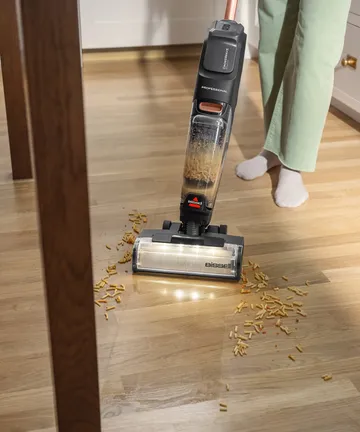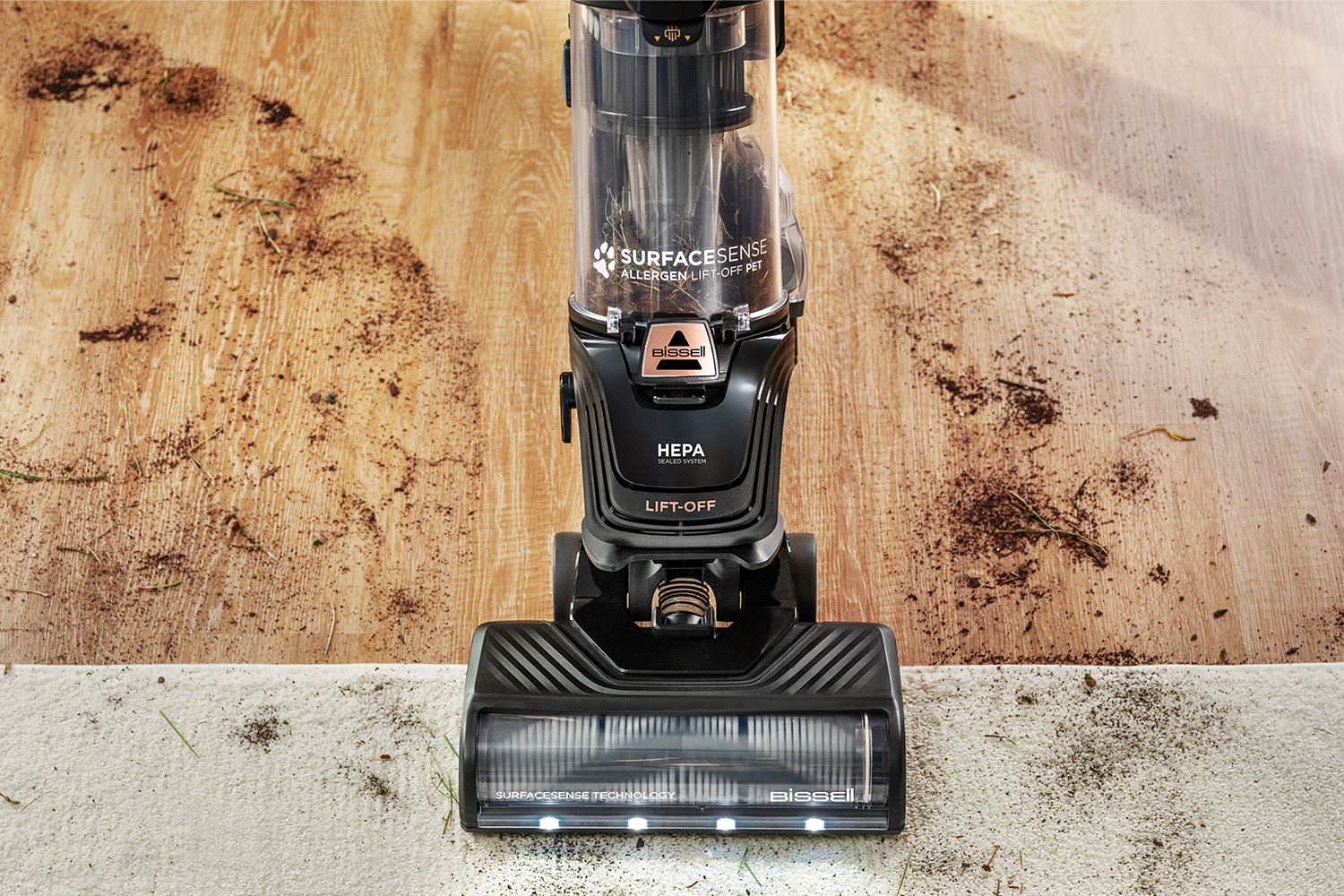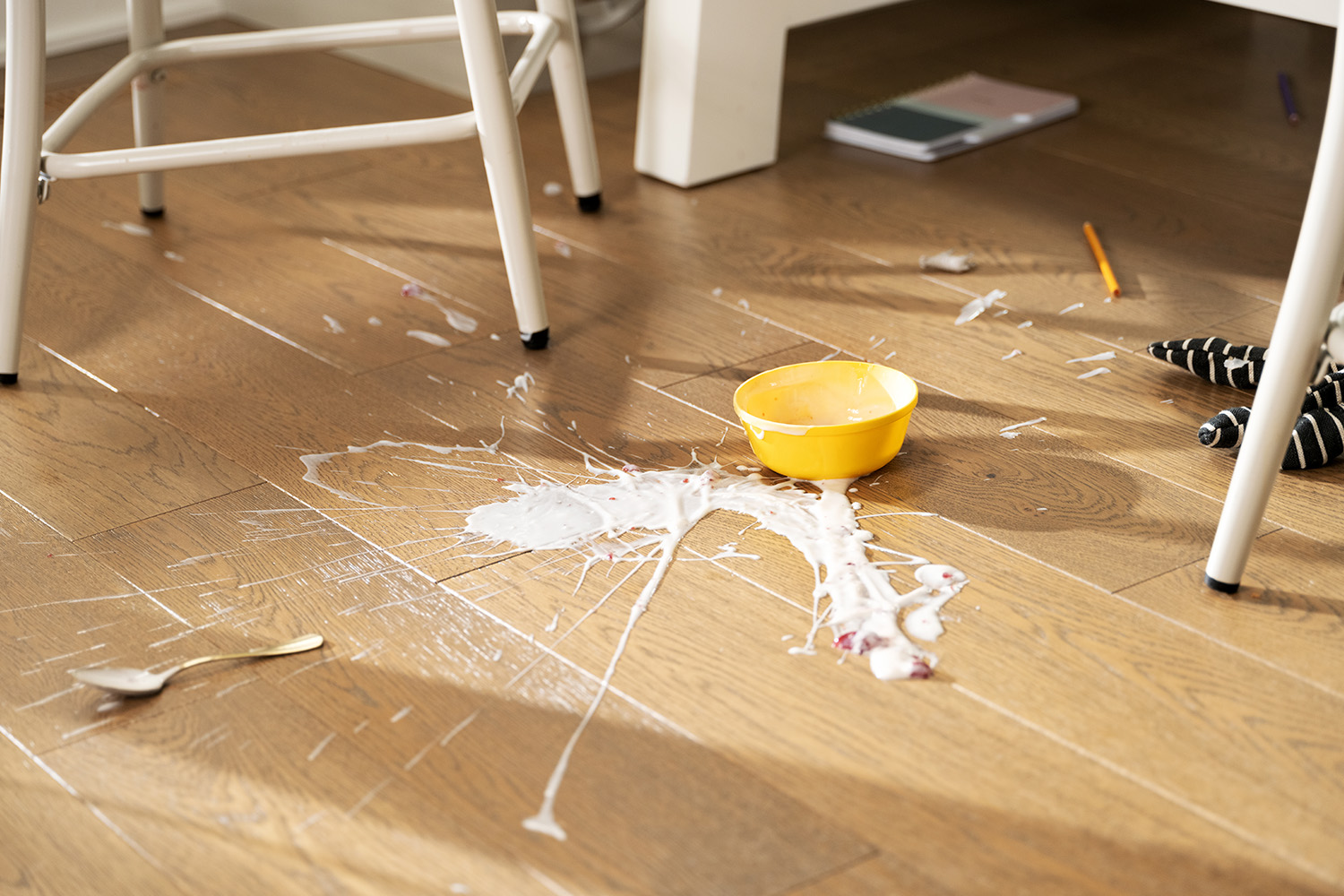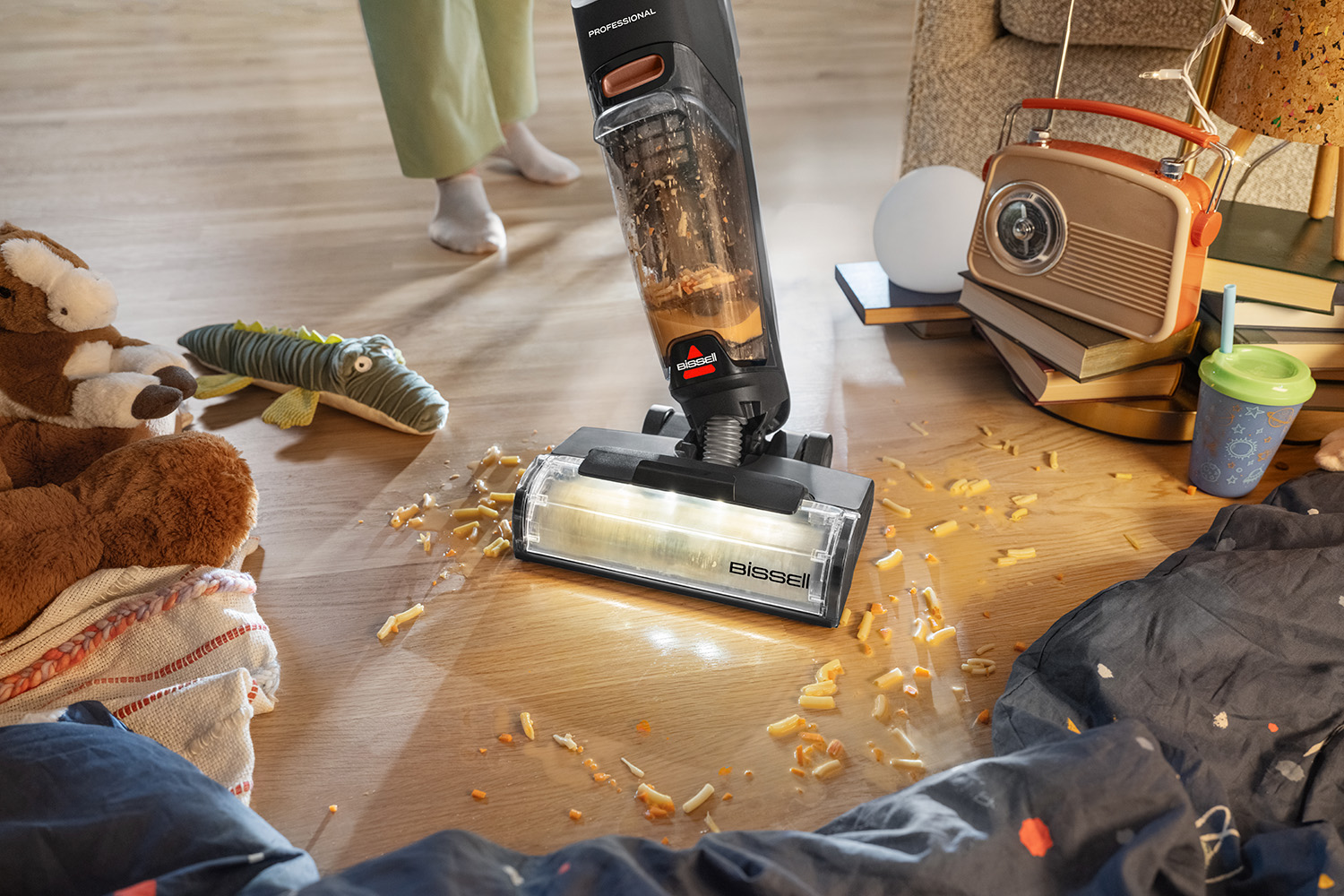How to Clean Laminate Floors
Floors that look like wood, without the cost? More homeowners are turning to laminate and other manmade flooring options for their durability and aesthetic appeal at a more affordable price. But because laminate is sensitive to moisture, cleaning it requires special care.
In this guide, our experts provide advice on how to clean laminate floors to maintain their appearance and durability – from basic cleaning steps to preventive measures – as well as a list of top cleaning tools for laminate.
One product that tops the list: the CrossWave® OmniFind™ All-in-One Multi-Surface Cleaner, which vacuums debris while dispensing just the right amount of cleaning solution to thoroughly mop sealed laminate without dousing the floors and causing damage.

Why laminate floors require special cleaning
Laminate floors are prized for their durability, but improper cleaning can cause damage.
The top layer of laminate flooring is designed to resist scratches and stains, but it isn't fully water-resistant, which can complicate cleaning. For instance, sealed laminate flooring can be cleaned with liquid floor cleaners, but a traditional mop may leave too much moisture on the surface, which can damage the flooring or cause it to buckle.
Using too much water, abrasive tools, or harsh cleaners can compromise the protective top layer of this manmade material, leading to expensive fixes. However, with a little know-how and a few simple steps, you can clean laminate floors in a way that ensures longevity and a beautiful finish.
Daily cleaning tips for laminate floors
When you need to remove everyday messes, such as a bit of dirt or a week’s worth of dust, vacuuming is the best approach. For small spills, try the spot-cleaning method detailed below.
Vacuum laminate floors
Vacuuming on a daily or weekly basis is one of the best ways to clean laminate floors, keeping them free from dulling debris.
Recommended cleaning products
- The lightweight SurfaceSense® Allergen Pet Lift-Off® Vacuum easily moves between different floor types and around furniture in tight spaces
Techniques for vacuuming
Pick up any larger debris you see, then move lightweight furniture and rugs so you can access the entire floor area.

When you vacuum laminate flooring, start in one corner and work your way back, making forward and backward passes over each area to ensure you pick up all dust and dirt particles. The SurfaceSense® Allergen Pet Lift-Off® Vacuum has powerful suction and built-in sensors that help it adjust automatically to any floor type.
Spot clean laminate flooring
There are two reasons to address spills and accidents as soon as they happen: Dried on messes are harder to remove and, when left on floors for long periods of time, they can cause deeper damage to laminate. With regular spot cleaning, you can tackle spills, stains, and grime that might harm the surface of your laminate floors.
Choosing the right spot cleaner
The protective layer found on laminate floors can be susceptible to damage, which is why it’s important to use cleaning solution that is safe on laminate floors.
For small splashes you catch in the moment, a damp cloth can effectively clean the space.
For stuck-on sticky messes, a specially designed hard floor or multi-surface cleaner that is safe for use on sealed laminate flooring is recommended.
It is best to avoid harsh chemicals like bleach and ammonia as well as DIY cleaners such as vinegar and baking soda (see more below on why DIY cleaners often don’t work). Because excess moisture can be detrimental to laminate, a traditional mop and bucket approach is not recommended and neither are steam mops.
Recommended cleaning products
- A damp clean cloth or paper towel
- Or, a mop + vac machine such as the CrossWave® OmniFind™ multi-surface cleaner filled with CrossWave™ Pet Pro Oxy Multi-Surface Formula, which features odor-eliminating ingredients and the cleaning power to remove tough, stuck-on messes
Techniques for spot cleaning laminate
For small spills that are still wet, such as a cup of coffee that sloshes over onto your laminate kitchen floor, a damp clean cloth or paper towel may be all you need to clean up the mess in the moment. If the area dries sticky, follow the below advice for dried-on spots.

For larger spills or dried on spots, hard floor cleaning solution and a wet dry vac are useful. The CrossWave® OmniFind™ multi-surface cleaner can vacuum and mop at the same time. A gentle, rotating mop brush will cover the area with formula and clean the floor while the machine’s suction power removes the spent solution and any debris.
If the spot is dried on, you may need to make a few passes over the area. The machine will pick up most of the cleaning formula. It’s safe to allow any leftover formula to air dry on sealed laminate flooring; very little formula will be left on the floor so it should dry in minutes.
Cleaning formula is much more effective than just water: CrossWave™ Pet Pro Oxy Multi-Surface Formula has odor elimination technology will help to keep your floors smelling nice and added cleaning surfactants to remove tough, sticky messes.
To be ready to clean your next spill, after you’re done, run the machine’s self-cleaning cycle and empty the dirty water tank.
Floor washing technique for laminate
While regular cleaning effectively removes loose particles and everyday messes, washing a hard floor cleaning tackles embedded dirt and grime that can build up over time. Follow these steps at least once a month to wash laminate floors.
Choosing the right hard floor cleaning machine and formula for laminate
Laminate floors are durable, but you still need to take care when cleaning with a liquid. Even sealed laminate flooring is susceptible to damage when left wet, so it’s important to deep clean with devices and formulas that are safe on laminate floors.
Cleaning with a hard floor or multi-surface cleaning machine such as a CrossWave® wet dry vac and a coordinating cleaning formula is recommended.
It is best to avoid harsh chemicals and DIY cleaners, which may not clean your floors effectively and may actually damage them. Because excess moisture can harm laminate or cause it to buckle, steer clear of traditional mops and steam mops.
Recommended cleaning products
- So you can vacuum and mop at the same time, we like the CrossWave® OmniFind™ multi-surface cleaner
- A cleaning formula such as CrossWave™ Pet Pro Oxy Multi-Surface Formula can effectively remove tough, stuck-on spills
Techniques for deep cleaning
For a truly deep clean, dust and debris must be removed. The CrossWave® OmniFind™ multi-surface cleaner vacuums and mops at the same time, so there’s no need to vacuum your laminate beforehand.
To prep your machine for deep cleaning, follow the instructions or measuring guides for adding water and cleaning formula to the clean water tank. Be sure to use warm but not overly hot or boiling water.

If your multi-surface cleaner has a solution dispensing trigger, turn on the machine, pressing the trigger to release cleaning solution onto the brush roll as you move forward, mopping the floor. Release the trigger as you pull back over the same section. This stops the spraying of cleaning solution, but the suction remains on, so debris and excess cleaning solution is drawn up and into the dirty tank.
Go over high traffic areas or spots multiple times if needed.
A thin coat of cleaning solution and water may be visible on the floor, but it should dry within minutes.
Run the self-cleaning cycle and empty the dirty water tank after use.
Cleaning laminate with vinegar and DIY cleaners
There are several homemade cleaning solutions that people commonly use to clean laminate, although the science is scarce when it comes to showing how well they work. In fact, in addition to not providing a deep clean, solutions such as vinegar, baking soda, dish soap, and even water can leave your floors dirty or even damaged, according to BISSELL chemists.
If you do clean your laminate floors with products not specifically designed for this use, the article “4 DIY Floor Cleaning Mistakes: Why Formulas Work Better than Water” will help you understand the streaking and stickiness you may be in store for.
Here are some quick reasons to steer clear of cleaning laminate with the following materials, according to BISSELL Principal Chemist Jay Kellis, who has designed floor cleaning solutions for more than 15 years.
- Why to avoid cleaning laminate with just water: Cleaning with just water leaves water spots and doesn’t actually wash away dirt and spots.
- Why vinegar isn’t good for cleaning laminate flooring: Without detergents, vinegar on its own cannot lift oils and stains.
- Why dish soap and laundry detergent are some of the worst DIY floor cleaners: These soaps are meant to be rinsed away. When left on a floor, they become sticky and attract messes.
How to keep laminate flooring clean and long lasting
Laminate flooring is durable, but it requires regular maintenance and upkeep to preserve its shine and longevity. Taking preventive measures allows you to keep your floors in top condition.
2 More ways to protect your laminate floors
In addition to regular cleaning, there are two additional ways you can protect your laminate floors from scratches, moisture, and other everyday messes and accidents.
Utilize floor mats and rugs
Place mats at entrances to trap dirt and moisture. Place area rugs in high-traffic areas to prevent wear and tear.
Use furniture pads
Temporary furniture pads or “sliders” can be used under furniture feet when rearranging furniture or moving it for cleaning purposes. Under furniture that’s moved regularly, such as dining room chairs that are slid in and out, you can use a more permanent pad. Round and square felt pieces with an adhesive backing can be stuck on the bottom of furniture that moves around to prevent scratches and avoid dragging furniture across your floors.
Laminate cleaning best practices and long-term maintenance tips
Use a vacuum for weekly cleaning, such as the SurfaceSense® Allergen Pet Lift-Off® Vacuum. For bi-weekly or monthly deep cleaning, go over laminate floors with a CrossWave® wet/dry vacuum filled with the appropriate cleaning formula. We like CrossWave® OmniFind™ multi-surface cleaner and CrossWave™ Pet Pro Oxy Multi-Surface Formula on sealed laminate floors.
Prompt spill management is another way to maintain the beauty and durability of your laminate flooring. As soon as you spot a spill, get it off your floors.
By following these methods and tips, you can ensure your laminate floors remain clean and damage-free for years to come. Always consult your flooring manufacturer for guidance on cleaning products and techniques.
Frequently asked questions
What is the best thing to clean laminate floors with?
For everyday use, the best way to clean laminate floors is to vacuum up loose particles. A wet/dry vacuum, such as the CrossWave® OmniFind™ multi-surface cleaner and a laminate-safe cleaning formula (we like CrossWave™ Pet Pro Oxy Multi-Surface Formula) can help you get a deeper clean once a month or so. These essential cleaning tools make it easy to restore the shine of your laminate floors by removing built-up grime and residue without damaging the laminate.
What cleaning tools and techniques should I avoid on laminate floors?
While laminate flooring is durable, there are certain products you should avoid using to prevent damaging the protective coating. Never use bleach or ammonia-based cleaners, as these may strip the finish. Additionally, avoid using steam mops, as the high temperature of the steam can remove the protective layer. You should also never use oil or wax-based products, which can leave behind a cloudy residue that takes away your floor’s shine. And, leaving excess water on the surface – such as by using a soaking wet mop – can also cause damage to a laminate floor.
Is it safe to clean laminate floors with vinegar and water?
It may be safe to cover your laminate floors with vinegar and water – but it won’t necessarily clean the laminate. To truly clean floors you need ingredients that will loosen and lift grime and dirt. For best results, clean laminate floors with a solution designed by chemists to be safe and effective on that specific surface.
How often should I clean my laminate floors?
To maintain the integrity of your laminate floors, you should spot clean daily, vacuum weekly, and deep clean monthly. This process helps ensure you manage messes as they happen while also preventing the buildup of grime and residue that can damage your laminate floors or make them appear dirty.
What is the best cleaning solution for laminate floors?
The best cleaning solution for laminate floors is a multi-surface cleaner that’s safe for this type of floor. CrossWave® devices, such as the CrossWave® OmniFind™ multi-surface cleaner, are compatible with a range of multi-surface formulas, such as the CrossWave™ Pet Pro Oxy Multi-Surface Formula. This powerful pairing can handle everything from pet messes to larger debris.